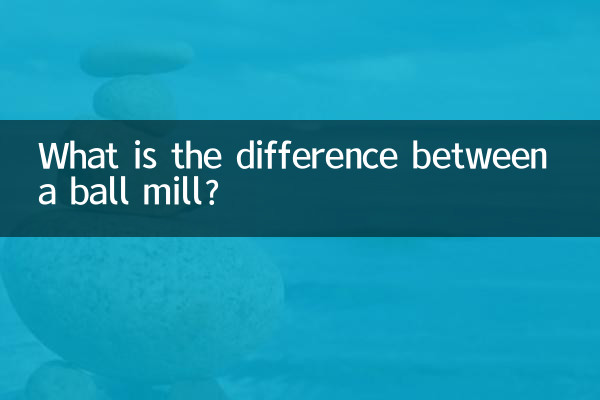What is the difference between a ball mill?
In industrial production, ball mills and vertical mills are two common grinding equipment, which are widely used in cement, metallurgy, chemical and other industries. Although their functions are similar, there are significant differences in structure, working principle, applicable scenarios, etc. This article will focus on popular topics in the past 10 days, combine structured data, and analyze in detail the difference between ball mills and stand-alone mills to help readers better choose suitable equipment.
1. Comparison of structure and working principle

There are obvious structural differences between ball mills and vertical mills, which directly affects their working principle and efficiency.
| Comparison items | Ball mill | Stand-alone |
|---|---|---|
| structure | Horizontal cylinder with grinding medium (steel ball) | Vertical cylinder with grinding disc and grinding roller inside |
| How it works | The cylinder rotates and drives the steel ball to impact the material | The millsplitting rollers rotate to crush the material |
| Grinding method | Combined with impact and grinding | Mainly crushing, supplemented by shearing |
2. Comparison of performance and efficiency
From the perspective of performance and efficiency, ball mills and vertical mills have their own advantages and disadvantages. The specific data are as follows:
| Comparison items | Ball mill | Stand-alone |
|---|---|---|
| Energy consumption | Higher power consumption accounts for a large proportion | Lower, significant energy-saving effect |
| Grinding efficiency | Lower, easy to over-powder | Higher, evenly distributed particle size |
| noise | Large, up to 85dB or more | Smaller, usually below 75dB |
| Maintenance cost | Higher, steel balls need to be replaced regularly | Lower, long life of the grinding roller |
3. Comparison of applicable scenarios
The applicable scenarios of ball mills and stand-alone mills vary depending on their performance differences:
| Comparison items | Ball mill | Stand-alone |
|---|---|---|
| Suitable materials | Materials with high hardness and strong wear resistance | Medium hardness, fragile materials |
| Production capacity range | Small and medium-sized scale | Large-scale production |
| Industry applications | Cement, metallurgy, mining | Cement, electricity, chemical industry |
4. Analysis of hot topics in the past 10 days
According to the network-wide search data over the past 10 days, the discussions on ball mills and stand-alone mills mainly focus on the following aspects:
1.Energy-saving and environmental protection: The vertical mill has become the first choice for green production due to its low energy consumption and low noise characteristics, and is particularly attracted more attention under the "dual carbon" goal.
2.Intelligent transformation: The ball mill has been equipped with sensors and AI control systems to optimize energy consumption, becoming a hot spot for traditional equipment upgrades.
3.Convenience of maintenance: The modular design of vertical mill reduces downtime and meets the needs of modern industry for efficient operation and maintenance.
V. Summary and Suggestions
Ball mills and vertical mills have their own advantages. When choosing, you need to comprehensively consider factors such as material characteristics, production scale, and energy consumption requirements:
-Ball millIt is more suitable for handling high-hardness materials and small-scale production, but requires high energy consumption and maintenance costs.
-Stand-aloneIt is outstanding in energy conservation and environmental protection and large-scale production, but it has certain restrictions on material adaptability.
With the advancement of technology, both devices are developing towards intelligence and efficiency. It is recommended that enterprises make choices based on actual needs and industry trends.

check the details

check the details